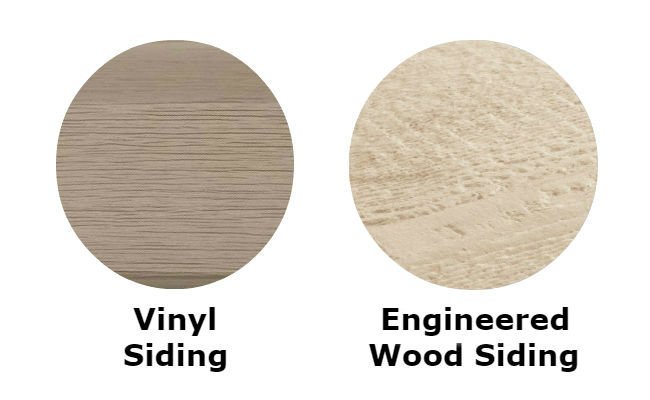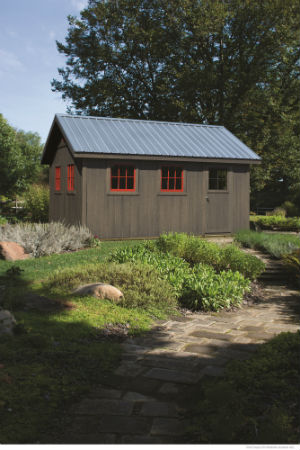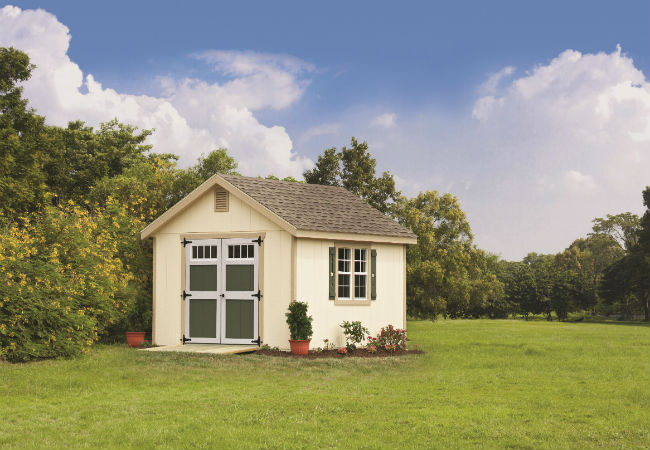We may earn revenue from the products available on this page and participate in affiliate programs. Learn More ›
Sheds perform a number of functions, from storing tools and lawn equipment to serving as a child’s playhouse. Whatever the purpose of your backyard building, if you want it to withstand the test of time, it’s essential that you choose materials that look good and stand up to the onslaughts of Mother Nature—and the neighborhood kids. Selecting the right siding can make the difference between a shed that complements your backyard landscape for years to come and one that looks old and tired in a few short seasons.
If you’re in the market for a shed and are trying to decide what type of siding to install, keep reading. Here, we take a comprehensive look at the differences between vinyl and engineered wood siding so you can choose the best option for your needs.
Engineered wood siding costs more than vinyl siding.
You’ll pay approximately $70 to $100 per square (100 square feet) for vinyl and $110 to $130 for LP® SmartSide® engineered wood siding. While vinyl siding may be less expensive overall depending on the type and quality of the siding you choose, the cheaper material doesn’t meet the performance standards of engineered wood siding developed by LP®, a company with more than 40 years of experience in manufacturing high-performance building solutions. As a result, it might be a good idea to weigh initial costs with the long-term investment of your shed.

Engineered wood siding is more aesthetically pleasing.
Though vinyl siding is manufactured to look like wood, the texture, which is created during the extrusion process, just doesn’t cut it. Upon close inspection, the “wood grain” patterns appear more uniform and manmade than natural. On the other hand, LP® SmartSide® engineered wood siding offers an authentic deep grain cedar appearance that closely mimics the look of traditional wood.
Vinyl siding is more likely to break on impact.
Some backyards see a lot of physical activity, such as ball-playing, Frisbee-throwing, and heavy-duty tool use. Vinyl siding is not as impact resistant as engineered wood siding, even from something as seemingly innocuous as the spinning line of a string trimmer. And when the weather is frigid, vinyl siding becomes brittle and is more likely to shatter—a problem that engineered wood siding doesn’t have. LP® SmartSide® siding consistently performs better than vinyl siding in impact testing and can withstand direct impacts, such as a neighbor’s misdirected golf ball.

Engineered wood siding resists thermal damage better than vinyl siding.
The patio or deck, a favorite spot for an outdoor grill, can be as little as a foot or so away from your shed. (And why not, when you may very well stow the grill, along with its tools and accessories, in the shed after a cookout?) If your grill is near the shed, be aware that strong radiant heat may damage vinyl siding. Heat from the back of a grill has been known to melt vinyl siding, requiring the complete replacement of the damaged area. Vinyl siding may also melt when struck by the concentrated rays of the sun—when, for example, a ray reflected off a nearby window becomes focused on the siding. Neither grill nor sun will pose a problem with LP® SmartSide® siding. In fact, engineered wood siding resists damage from both radiant heat and amplified sun rays.
Vinyl siding has a tendency to warp.
Unfortunately, both improper installation (nailing the siding too tightly) and temperature fluctuations (which can cause the siding to expand and contract) can leave vinyl siding looking wavy. Inexpensive vinyl siding is more prone to warping than higher-quality vinyl, but the risk still exists with most brands. The manufacturing process of engineered wood, however, binds together wood strands or fibers, waxes, and resins under pressure to achieve a strong, durable siding product.
Longer siding lengths mean fewer seams.
Seams interrupt the clean appearance of siding, so the fewer seams on your shed, the better it will look. It’s important to note that vinyl siding comes in lengths of up to 12 feet, while LP® SmartSide® engineered wood panels come in 16-foot lengths. If your shed is small (less than 12 feet on each side), this difference won’t matter because you can install either type of siding without any seams. For larger sheds and outbuildings, however, 16-foot-long pieces of engineered wood siding may translate into fewer—or no—seams in comparison with the shorter lengths of vinyl.
Vinyl siding may be easier for homeowners to install themselves.
Of all the types of siding on the market, vinyl is the most DIY-friendly, because it comes with everything you need, including starter strips, fascia, channels, and outside corners that cover the rough-cut ends of the siding, and these pieces simply snap together as they’re installed. Engineered wood siding requires precise measuring and cutting, and if installing lap siding, the installer must be able to create equal lap overhangs. So, engineered wood siding will take a little longer to install, but it may be a better investment in the long-term.
If you don’t have the time or the skills for this sort of project, you’re in luck: Shed dealers who build with these quality materials may offer their services and build your shed on-site. You can locate a dealer who sells durable LP® Outdoor Building Solutions®—SmartSide® Lap Siding as well as SmartSide® Wall Panels, LP® ProStruct® Roof Sheathing, and LP® ProStruct® Flooring—through LPShed.com.
Either siding material may have restrictions in your neighborhood.
For reasons listed above, vinyl siding may be restricted in neighborhood building covenants where engineered wood siding is welcomed. But, in an area with high fire danger, it’s engineered wood siding that may not be allowed. These restrictions may also apply not just to your house, but to any sheds or outbuildings in your yard. If your residential development has covenants, or if you live in a neighborhood with a homeowners association (HOA), do not attempt to build or install a shed without first clearing the plans—materials included—with the HOA or development committee.
This content has been brought to you by LP Building Products. Its facts and opinions are those of BobVila.com.


